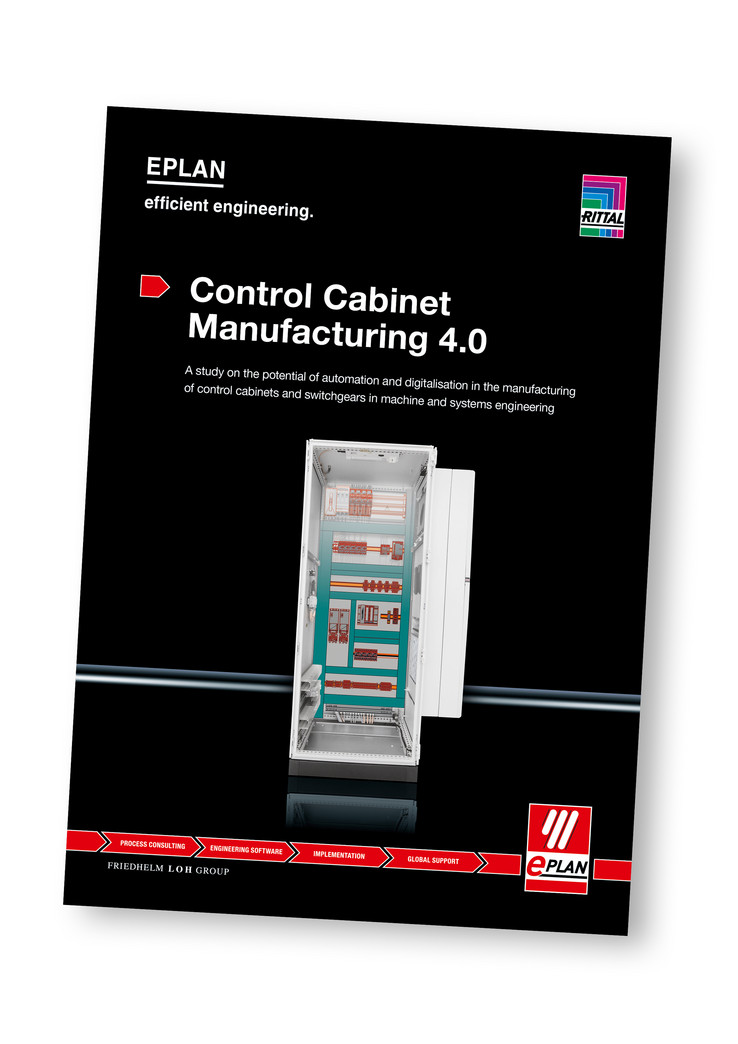New control cabinet engineering study
The 39-page research report is based on a field survey amongst German control cabinet manufacturers
ISW research report available exclusively at EPLAN
What does the future bring for control cabinet manufacturing? The Institute for Control Engineering of Machine Tools and Manufacturing Units (ISW) at the University of Stuttgart considered this question. Its 39-page research report is based on a field survey amongst German control cabinet manufacturers. The scientists analyse the current state of manufacturing, provide specific recommendations for action, and outline the major trends in the era of integrated information chains and intelligent, self-operating machines.
Monheim, Germany, 23 February 2018 – The average schematic contains 320 pages, and the average time required for wiring according to this diagram takes 54 hours, accounting for 49 percent of the total time required for manufacturing. For an average of 500 wires per control cabinet, almost 17 hours alone are spent reading the documents. These are a few of the exemplary findings of the study “Control Cabinet Manufacturing 4.0 – A Study on the Potential of Automation and Digitalisation in the Manufacturing of Control Cabinets and Switchgears in Machine and Systems Engineering” published by the ISW at the University of Stuttgart.
Potential for savings in engineering
From the collected data, the scientists found that companies still using project-driven or task-driven working methods could save 45 percent of the time required for their engineering processes by switching to functionally oriented, modular schematics. Schematics and design drawings must be subdivided into modular and functional units to achieve this. In turn, these units must only be designed and tested once to be used afterwards without any additional testing. Only the functional aspects must be considered moving forward – for instance to clarify whether one or two pressure sensors are wanted. According to the study, the next step – the introduction of option techniques and product configurators – exhibits a savings potential of around 40 per cent.
3D is the key
Overall it is notable, however, that 92 percent of study participants still use two-dimensional engineering. Prof. Dr.-Ing. Alexander Verl, director of the Institute for Control Engineering of Machine Tools and Manufacturing Units, says: “Generally the question arises: Why are two-dimensional manufacturing plans still being created in engineering when control cabinet manufacturing takes place in three dimensions? This dimension reduction is rather counterintuitive and also counterproductive. Up to 35 percent of engineering time and up to 22 percent of manufacturing time can be saved since the construction plans can be trusted completely. Three-dimensional construction drawings also offer benefits for workers and in production itself.” The ISW study continues, stating that savings in manufacturing time of up to 55 percent can be achieved in mechanical processing if digital construction drawings, for example, are used in machining the control cabinet’s mounting panels and side panels. And 90 percent less time expenditure becomes necessary for installing electrical components when digital control cabinet models are used for terminal pre-assembly.
Networking through intelligence
The Control Cabinet Manufacturing 4.0 study additionally looks at trends such as flow manufacturing vs. nesting production, outsourcing and in-house production, and multimedia devices. It also deals with the topic of the necessity of more logic and intelligence with respect to an increasingly networked production environment, which is faced with a great number of decentralised control cabinets with more component diversity and operating equipment. Maximilian Brandl, President of EPLAN, says, “The study is highly recommended. It offers all control cabinet manufacturing companies a variety of opportunities for contemplation and very vividly describes the potentials for increasing efficiency within companies.”
Study design
The four-member research team first analysed current practices for control cabinet manufacturing at twelve German companies. To ensure as representative a description of the present situation as possible, small machine and system producers were equally taken into account for the study as larger corporations. Of the companies surveyed, 78 percent realise control cabinet manufacturing in-house; 63 percent mentioned a large diversity of components and indicated more than 50 percent customised parts. The study subdivided the individual findings in the design/engineering and manufacturing/assembly departments into the process profiles of “traditional”, “standardised” and “automated”. Average time specifications for specific work steps are also addressed.
©EPLAN, March 2018



